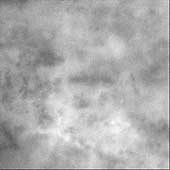|
COMETS EARTH JUPITER KUIPER BELT MARS MERCURY METEORITES NEPTUNE OORT CLOUD PLUTO SATURN SOLAR SYSTEM SPACE SUN URANUS VENUS ORDER PRINTS
PHOTO CATEGORIES SCIENCEVIEWS AMERICAN INDIAN AMPHIBIANS BIRDS BUGS FINE ART FOSSILS THE ISLANDS HISTORICAL PHOTOS MAMMALS OTHER PARKS PLANTS RELIGIOUS REPTILES SCIENCEVIEWS PRINTS
|
Related Documents
Download Options
This image shows one of the closest views of Xanadu Regio, a large bright region on Titan's surface, which also can be seen in a more distant view taken earlier (see PIA06185). In this close-up view, brightness variations can be seen within Xanadu. The bright material on Titan is thought to be more water-ice rich, while darker regions may indicate areas where more hydrocarbon-rich material has collected. It is not clear from the patterns seen here what processes caused them. However, this image is just a single piece of a larger 5 by 5-frame mosaic that covers the western part of Xanadu and the dark area that lies farther to the west. When the complete mosaic is assembled, larger-scale patterns may be identified that will help to reveal the processes that have shaped Titan's surface. The area shown here is approximately 700 kilometers (435 miles) across, centered at roughly 16 south, 133 west on Titan. Three narrow-angle camera images taken with the Cassini spacecraft in wavelengths of infrared light centered at 938 nanometers were combined to create this view. The images were acquired during a close encounter with Titan on Feb. 15, 2005, at a distance of approximately 114,000 kilometers (71,000 miles) from Titan, which corresponds to a image scale of 680 meters (2,231 feet) per pixel. As a result of scattering within Titan's atmosphere, the scale of surface features that can actually be resolved at this range is several kilometers. The Sun-Titan-spacecraft, or phase, angle was 20 degrees when these images were acquired. |
